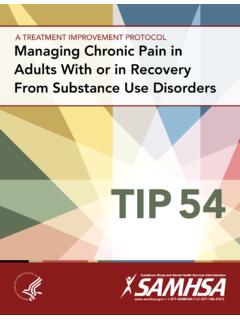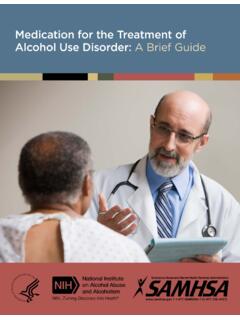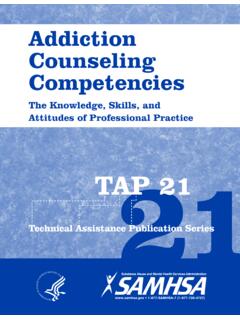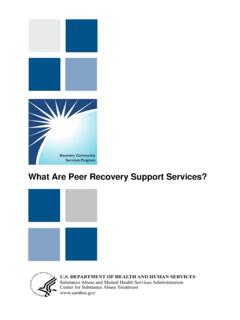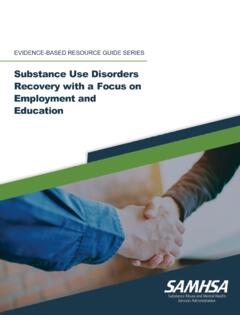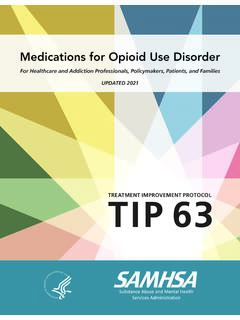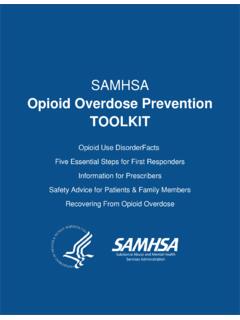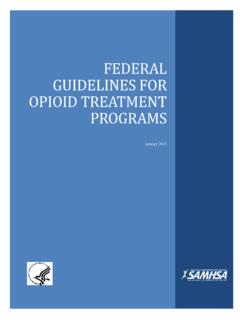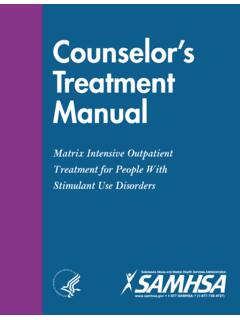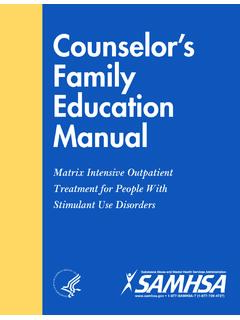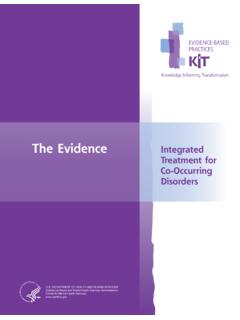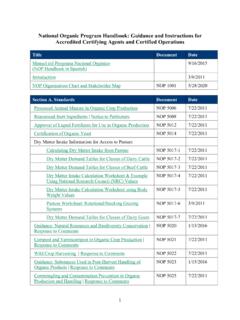Transcription of Substance Use Disorder Treatment for People With Co ...
1 Substance Use Disorder Treatment for People With Co- occurring Disorders UPDATED 2020 Treatment IMPROVEMENT PROTOCOL TIP 42 This page intentionally left 42 Please share your thoughts about this publication by completing a brief online survey at: The survey takes about 7 minutes to complete and is anonymous. Your feedback will help SAMHSA develop future products. i This page intentionally left 42 Contents Foreword vii Executive Summary ix Overall Key Messages ix Content Overview x Consensus Panel
2 Xvii TIP Development Participants xvii KAP Expert Panel and Federal Government Participants xviii Publication Information xxvii Chapter 1 Introduction to Substance Use Disorder Treatment for People With Co- occurring Disorders 1 Scope of This TIP 2 Terminology in This TIP 3 Important Developments That Led to This TIP Update 6 Why Do We Need a TIP on CODs?
3 7 The Complex, Unstable, and Bidirectional Nature of CODs 11 Conclusion 12 Chapter 2 Guiding Principles for Working With People Who Have Co- occurring Disorders 13 General Guiding Principles 14 Guidelines for Counselors and Other Providers 16 Guidelines for Administrators and Supervisors 21 Conclusion
4 29 Chapter 3 Screening and Assessment of Co- occurring Disorders 31 Screening and Basic Assessment for CODs 32 The Complete Screening and Assessment Process 36 Considerations in Treatment Matching 65 Conclusion 68 Chapter 4 Mental and Substance -Related Disorders: Diagnostic and Cross-Cutting Topics 69 Depressive Disorders 71 Bipolar I Disorder 76 Posttraumatic Stress Disorder 83 Personality Disorders 89 Anxiety Disorders 98
5 Schizophrenia and Other Psychotic Disorders 104 Attention Defcit Hyperactivity Disorder 110 iii TIP 42 Substance Use Disorder Treatment for People With Co- occurring Disorders Feeding and Eating Disorders 114 Substance -Related Disorders 121 Cross-Cutting Topics: Suicide and Trauma 129 Conclusion 140 Chapter 5 Strategies for Working With People Who Have Co- occurring Disorders 141 Competencies for Working With Clients Who Have CODs Guidance for Working With Clients Who Have Specifc 142 Guidelines for a Successful Therapeutic Relationship 142 Protect Confdentiality
6 148 Co- occurring Mental Disorders 160 Conclusion 163 Chapter 6 Co- occurring Disorders Among Special Populations 165 People Experiencing Homelessness 166 People Involved in the Criminal Justice System 170 Women 172 People of Diverse Racial/Ethnic Backgrounds 179 Conclusion 182 Chapter 7 Treatment Models and Settings for People With Co- occurring Disorders 183 Treatment Overview 184 Treatment Models 188 Empirical Evidence for ACT 192 Treatment Settings 203 Pharmacotherapy
7 220 Chapter 8 Workforce and Administrative Concerns in Working With People Who Have Co- occurring Disorders 229 Recruitment, Hiring, and Retention 230 Avoiding Burnout 233 Competency and Professional Development 234 Conclusion 243 Appendix A Bibliography 245 Appendix B Resources 285 Training for Providers and Administrators 285 Other Resources for
8 Counselors, Providers, and Programs 287 Client and Family Resources 293 iv TIP 42 Appendix C Provider Forms, Measures, and Tools 297 Biopsychosocial Intake Forms 297 Suicide and Safety Screening and Assessment Tools 297 Mental Disorder Screening and Assessment Tools 297 Substance Use/Misuse Screening and Assessment Tools 297 Trauma Screening and Assessment Tools 299 Levels of Care Tool 299 Functioning and Disability
9 Tools 310 Stage of Change Tools 310 Additional Screening Tools for Common Mental Disorders 313 Exhibits Exhibit 1 1 Key Terms 3 EXHIBIT 1 2 Co- occurring Substance Misuse in Adults Ages 18 and Older With and Without any Mental Illness and SMI (in 2018) 7 Exhibit 2 1 Six Guiding Principles in Treating Clients With CODs 16 Exhibit 2 2 Making No Wrong Door a Reality 19 Exhibit 2 3 The Four Quadrants Model 20 Exhibit 2 4 SAMHSA Practice Principles of Integrated Treatment for CODs 21 Exhibit 2 5 Levels of Program Capacity in CODs 31 Exhibit 3 1 Assessment Considerations for Clients With CODs 39 Exhibit 3
10 2 Biopsychosocial Sources of Information in the Assessment of CODs 40 Exhibit 3 3 Recommended Screening Tools To Help Detect CODs 44 Exhibit 3 4 The Suicide Behaviors Questionnaire-Revised (SBQ-R) - Overview 46 Exhibit 3 5 SBQ-R-Scoring 46 Exhibit 3 6 SBQ-R Suicide Behaviors Questionnaire - Revised
